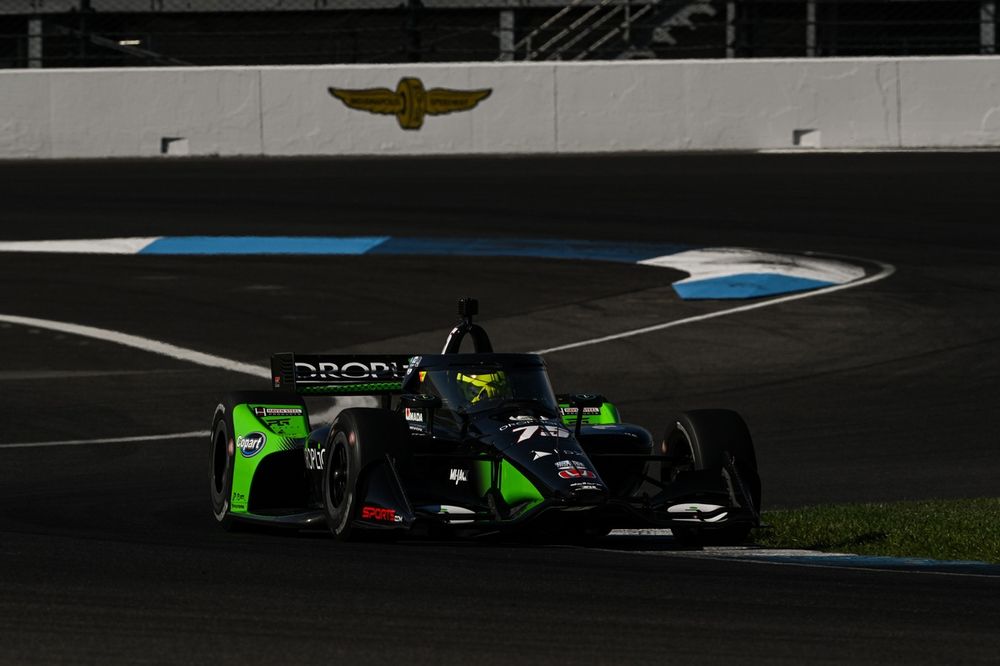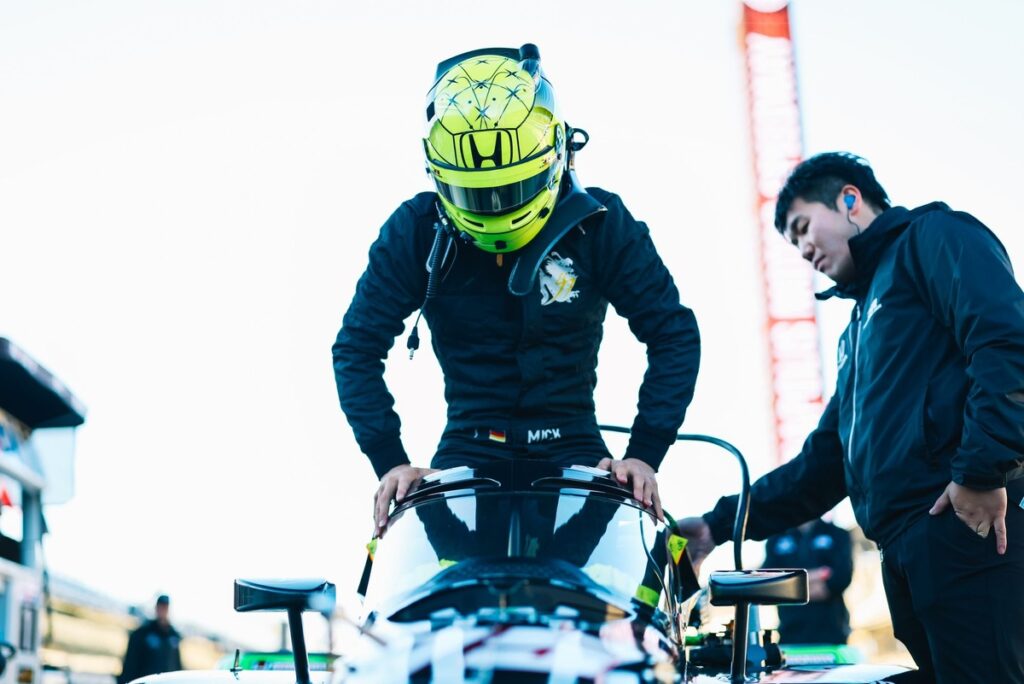“It being a single-seater, I think that’s what kind of attracts me to it,” Schumacher told a group of select media, including Motorsport.com, when asked what drew him to fly to the United States and test an IndyCar for the first time.
“I love having open wheels. One of the things my dad always said was, ‘The Schumachers are usually faster if they can see their wheels.’ I kind of like that quote. And I think it’s just the appeal of racing 17 times a year,” he added, contrasting that with WEC’s eight rounds, where he currently competes for Alpine.
Learning the lingo and loving the atmosphere
Watch: Mick Schumacher IndyCar test
Driving the Dallara DW12-Honda was the culmination of a well-planned process that began on Friday with a session on Honda’s simulator and continued with a visit to RLL’s shop in Zionsville, Indiana.
“They were great. It really feels like a family-owned team, because you can sense that everybody enjoys what they’re doing and they’re there because they’re passionate about motorsport,” he said of Rahal Letterman Lanigan Racing. “That’s something I felt right away walking into the workshop — everybody is excited about racing and eager to have people try their cars and give feedback so they can move forward and improve.”
Having spent his entire career in Europe, Schumacher also faced a few language barriers when it came to specific racing terms. “Like, new tires isn’t new tires — it’s ‘stickers’ here. The first time they said it, I was like, ‘What is stickers?’” he said with a smile. “Communication is a bit different. Obviously, we’re doing things in feet and yards. PSI here is not so different because that’s what we did in F1. Pounds are something completely new to me. A lot of things were a bit different, but it’s good to work with another metric system and get to know it.”
From F1 to IndyCar: key differences

Mick Schumacher, Rahal Letterman Lanigan Racing
Photo by: Penske Entertainment
While Schumacher discovered plenty of differences behind the wheel of an IndyCar, he was also able to relate it to previous experience. “It feels very much like an F2 car — maybe a little heavier in terms of steering,” he explained.
When asked to elaborate on the differences between driving an IndyCar and a Formula 1 car, which he raced for Haas between 2021 and 2022, Schumacher said: “Obviously I think it’s all a bit more — maybe this sounds bad — but a bit more old-school. In an IndyCar it’s more rough, and F1 is probably more fine-tuned. Aero pieces are important and crucial. If one little piece doesn’t sit right, it can affect the whole car.
“There’s a different approach, with IndyCar being a spec series, which has a lot to do with keeping costs down. In F1, if you have more money, you’ll spend it.
“The procedures are a bit different — sometimes I would say clinical in F1 and very precise — while here it’s maybe a bit more, yeah, rough, with more contact to the road. The fact that they don’t really have a skid was very interesting to me. It’s just the tub that’s the limit. As long as you don’t break the tub, you’re good to go. There are a couple of differences that are very interesting.
“I think you can bring stuff from IndyCar to F1, but vice versa there’s also a lot you can transfer from Formula 1 into IndyCar to maybe improve.”
Will Mick pursue a career in IndyCar?
Mick Schumacher, Rahal Letterman Lanigan Racing
Photo by: Penske Entertainment
The million-dollar question now is whether Schumacher will turn his first IndyCar test into a full-time ride when the series kicks off its 2026 season on the streets of St. Petersburg on March 1.
“I still have to let everything sink in a bit, figure it out, and make a decision down the line. It’s hard to say how high the percentage is. Today was a lot of fun, but I need to analyze a bit more and see what that would look like,” he said. “I think in terms of what I’m doing in ‘26, it’s very open. Obviously, the options are all there. IndyCar is one of them, so I really just wanted to know what it was like so I can make up my mind.”
One thing Schumacher made clear is that whether he stays in Europe or moves to America, he will commit to a single program and has ruled out combining his current WEC duties with Alpine with a partial IndyCar calendar.
“Obviously if I were to commit to any championship, I would do it 100%. Dual programs are not really on my radar, as I feel it would take a lot of energy and be pretty distracting to do both. So if I were to commit, I’d commit 100% to one or the other.”
When asked if he has a timeline for his decision and whether he wants to test on an oval first, Schumacher replied: “Obviously at some point I want to be sure about my future, so I think it won’t be too long before I make a decision. Whether that’s going to happen before or after I do an oval test, I don’t know.”
Racing on ovals is often a decisive factor for European drivers coming to IndyCar, but Schumacher isn’t worried and plans to embrace the challenge if he makes the move.
“I think safety is obviously a high priority for everybody. IndyCar has made a lot of adjustments and changes to make it safer, and I’m sure they’ll keep improving,” he said. “At some point, though, you can only make it so safe with the speeds you’re going. But again, I think all the precautions have been taken. I haven’t driven an oval, so I can’t say more than that, but for now I haven’t heard anything that would scare me off.”
Whether it’s ovals, street circuits or road courses, Schumacher was clear about what drew him to the IndyCar world.
“I think the one word that stuck with me the most was from someone who works here in IndyCar — that the most important aspect of the team, or of making a decision, is the driver at the end of the day. The fact that they rely so heavily on the driver really sparked my interest and made it interesting for me to come out and try.”
We want your opinion!
What would you like to see on Motorsport.com?
Take our 5 minute survey.
– The Motorsport.com Team
Read the full article here


